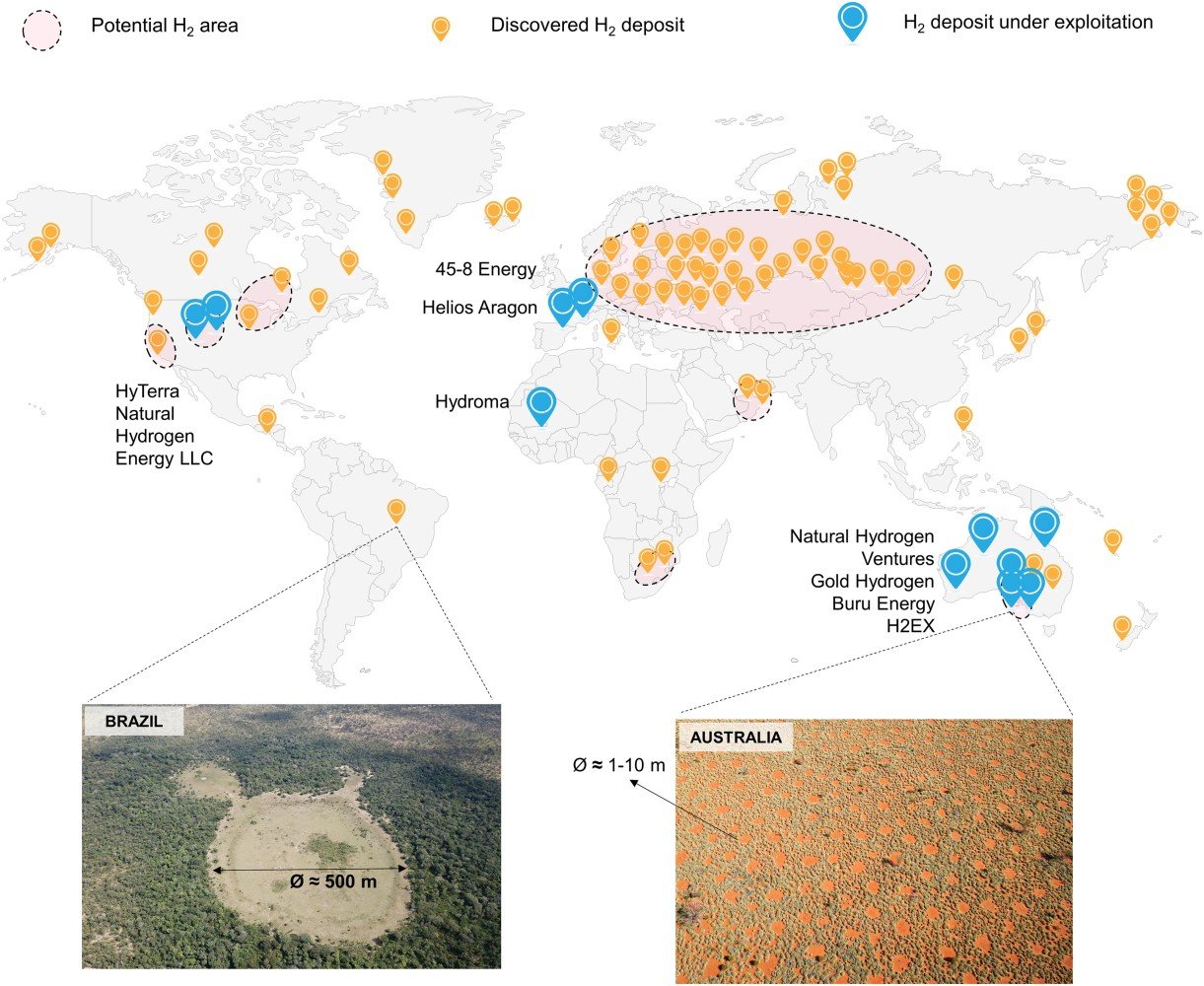Natural Hydrogen: Is it really the Golden Goose?
Recently I came across the incredible stories of 𝐁𝐨𝐮𝐫𝐚𝐤é𝐛𝐨𝐮𝐠𝐨𝐮, a small village in 𝐌𝐚𝐥𝐢, 𝐋𝐨𝐬 𝐅𝐮𝐞𝐠𝐨𝐬 𝐄𝐭𝐞𝐫𝐧𝐨𝐬 (The eternal flames) in the 𝐏𝐡𝐢𝐥𝐢𝐩𝐩𝐢𝐧𝐞𝐬 and the 𝐌𝐨𝐧𝐳ó𝐧 𝐍𝐚𝐭𝐮𝐫𝐚𝐥 𝐇𝐲𝐝𝐫𝐨𝐠𝐞𝐧 𝐏𝐫𝐨𝐣𝐞𝐜𝐭 in 𝐒𝐩𝐚𝐢𝐧 that have become global pioneers in natural hydrogen energy.
"𝘐𝘯 1987, 𝘸𝘦𝘭𝘭 𝘥𝘪𝘨𝘨𝘦𝘳𝘴 𝘩𝘢𝘥 𝘤𝘰𝘮𝘦 𝘵𝘰 𝘩𝘪𝘴 𝘷𝘪𝘭𝘭𝘢𝘨𝘦 𝘰𝘧 𝘉𝘰𝘶𝘳𝘢𝘬é𝘣𝘰𝘶𝘨𝘰𝘶, 𝘔𝘢𝘭𝘪, 𝘵𝘰 𝘥𝘳𝘪𝘭𝘭 𝘧𝘰𝘳 𝘸𝘢𝘵𝘦𝘳, 𝘣𝘶𝘵 𝘩𝘢𝘥 𝘨𝘪𝘷𝘦𝘯 𝘶𝘱 𝘰𝘯 𝘰𝘯𝘦 𝘥𝘳𝘺 𝘣𝘰𝘳𝘦𝘩𝘰𝘭𝘦 𝘢𝘵 𝘢 𝘥𝘦𝘱𝘵𝘩 𝘰𝘧 108 𝘮𝘦𝘵𝘦𝘳𝘴. “𝘔𝘦𝘢𝘯𝘸𝘩𝘪𝘭𝘦, 𝘸𝘪𝘯𝘥 𝘸𝘢𝘴 𝘤𝘰𝘮𝘪𝘯𝘨 𝘰𝘶𝘵 𝘰𝘧 𝘵𝘩𝘦 𝘩𝘰𝘭𝘦,” 𝘒𝘰𝘯𝘢𝘳é 𝘵𝘰𝘭𝘥 𝘋𝘦𝘯𝘪𝘴 𝘉𝘳𝘪è𝘳𝘦, 𝘢 𝘱𝘦𝘵𝘳𝘰𝘱𝘩𝘺𝘴𝘪𝘤𝘪𝘴𝘵 𝘢𝘯𝘥 𝘷𝘪𝘤𝘦 𝘱𝘳𝘦𝘴𝘪𝘥𝘦𝘯𝘵 𝘢𝘵 𝘊𝘩𝘢𝘱𝘮𝘢𝘯 𝘗𝘦𝘵𝘳𝘰𝘭𝘦𝘶𝘮 𝘌𝘯𝘨𝘪𝘯𝘦𝘦𝘳𝘪𝘯𝘨, 𝘪𝘯 2012. 𝘞𝘩𝘦𝘯 𝘰𝘯𝘦 𝘥𝘳𝘪𝘭𝘭𝘦𝘳 𝘱𝘦𝘦𝘳𝘦𝘥 𝘪𝘯𝘵𝘰 𝘵𝘩𝘦 𝘩𝘰𝘭𝘦 𝘸𝘩𝘪𝘭𝘦 𝘴𝘮𝘰𝘬𝘪𝘯𝘨 𝘢 𝘤𝘪𝘨𝘢𝘳𝘦𝘵𝘵𝘦, 𝘵𝘩𝘦 𝘸𝘪𝘯𝘥 𝘦𝘹𝘱𝘭𝘰𝘥𝘦𝘥 𝘪𝘯 𝘩𝘪𝘴 𝘧𝘢𝘤𝘦."
Natural (white/gold) Hydrogen, although not yet commercially viable on a large scale, is mainly produced through natural reactions i.e. via Radiolysis, serpentinisation and is extracted directly from underground reservoirs, is touted as a gamechanger in the hunt for cost-effective, low-carbon energy sources with approx. 40 exploration companies leading exploratory efforts world-wide, with countries like Oman (I.e. The Samail Ophiolite formation) regarded as a highly prospective country for the 'near-term' discovery of commercial quantities.
One of the most promising elements of Natural Hydrogen is its potential cost advantage (if it can be economically recovered) over other forms of hydrogen due to its natural occurrence, albeit the cost of renewable 'Green' hydrogen is also expected to come down in the coming years. Also, the infrastructure requirements for extraction are similar to those already used for natural gas.
In addition to the cost advantage, Natural Hydrogen can also have a low carbon intensity - which helps to mitigate climate change, again due to its natural formation, minimal processing & typically high purity e.g. 85% with minimal methane contamination.
Environmentally, extraction operations from underground reservoirs can involve potentially disturbing natural ecosystems whilst also negatively impacting the 'carbon footprint' of Natural Hydrogen - defending the case to develop Green Hydrogen infrastructure further due to its renewable resource use plus minimal environmental impact. Also, similar to our friends 𝐥𝐢𝐭𝐡𝐢𝐮𝐦 and 𝐜𝐨𝐛𝐚𝐥𝐭 (classed as 'critical' in the #EUCriticalRawMaterialsAct) - it is limited to specific, finite geological formations, less widely available and thus protection against resource depletion is a must.
Extraction operations may face regulatory challenges and public scrutiny taking lessons from fracking methods used in shale gas extraction - with some countries still imposing a ban on shale gas exploration.
The South Australian government appears to be leading the way by adding hydrogen to its list of regulated substances (2021) and by establishing the #HydrogenandRenewableEnergyAct2023 - helping to manage the risks associated with its production and use (adopting a risk-based approach taking lessons from the North Sea's #PiperAlpha incident in 1988). It is crucial that environmentally-sound (𝐚𝐧𝐝 𝐬𝐚𝐟𝐞) exploration strategies and resource assessment methodologies are developed globally as geologists signal the start of a new energy “𝐠𝐨𝐥𝐝 𝐫𝐮𝐬𝐡”.
Another challenge relates to operational efficiency - understanding how best to retain it and prevent its migration to the surface - since hydrogen is notoriously difficult to contain (winning the award for the lightest element on the Periodic Table). Likewise, cost-effective solutions are required for storage, transportation (i.e. via pipelines, cryogenically liquified road transport or conversion to ammonia) and distribution.
We hope you found this article useful!
If you require assistance developing a decarbonisation approach in your business or industrial facility…we are here to support you every step of the way.
Contact — Biyat Energy & Environment Ltd (biyatenergyenvironment.com)
This article was written by Luay Zayed, founder of Biyat Energy & Environmental Ltd. A global energy and environmental consultancy specializing in turnkey engineering solutions that protect the environment and improve energy efficiency in the manufacturing & industrial sectors.
Check out another recent article related to Green Hydrogen:
Eco-Friendly Solutions for Large Data Centre Backup Power | LinkedIn
Photo credits & further reading:
Golden Eggs Photo by Alexander Grey on Unsplash
https://ars.els-cdn.com/content/image/1-s2.0-S1364032123007463-gr4_lrg.jpg
https://www.youtube.com/watch?v=zlvzqboq_hM
https://www.youtube.com/watch?v=AxE4pQhgonI
'Drilling for Green Gold - Bourakébougou's Hydrogen Powered Future'.
https://www.youtube.com/watch?v=0NtAgZdvGKY&t=456s
https://knowledge.energyinst.org/new-energy-world/article?id=138647
https://www.ft.com/content/81819f64-1025-489b-959a-c3d9b14cc77a





